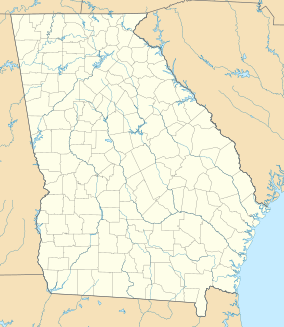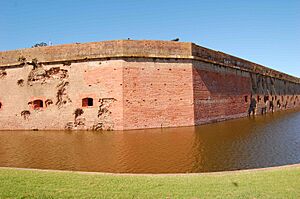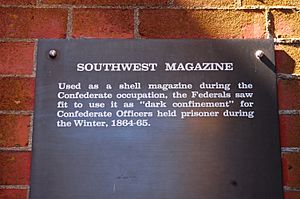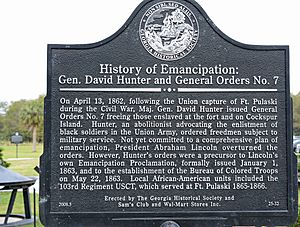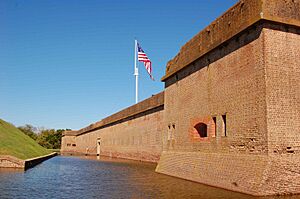Fort Pulaski National Monument facts for kids
Quick facts for kids Fort Pulaski National Monument |
|
|---|---|
 |
|
| Location | Chatham County, Georgia, USA |
| Nearest city | Savannah, Georgia |
| Area | 5,623 acres (22.76 km2) |
| Created | October 15, 1924 |
| Visitors | 408,104 (in 2011) |
| Governing body | National Park Service |
| Website | Fort Pulaski National Monument |
| Area | 260 acres (105.2 ha) |
| Built | 1847 |
| Architect | Bernard, Simon |
| NRHP reference No. | 66000064 |
| Added to NRHP | October 15, 1966 |
Fort Pulaski National Monument is a special place in Georgia, located on Cockspur Island. It's found between the cities of Savannah and Tybee Island. This monument protects Fort Pulaski, a historic fort that played a big role in the American Civil War.
In 1862, the Union Army successfully tested new, powerful cannons here. These cannons could shoot much farther and more accurately than older ones. Their success showed that old brick forts, like Fort Pulaski, could no longer withstand attacks. The fort was also used to hold prisoners during the war. The National Monument includes most of Cockspur Island and all of nearby McQueens Island.
Contents
Building Fort Pulaski: A Strong Defense
After the War of 1812, the United States wanted to build strong forts along its coast. This was to protect the country from future invasions. Construction on Fort Pulaski began in 1829. It was built to guard the important port of Savannah.
A young officer named Robert E. Lee, who had just graduated from West Point, helped with the early construction. In 1833, the fort was named after Casimir Pulaski. He was a brave Polish soldier who fought for America during the American Revolution. Pulaski was known for his cavalry skills and helped train American troops.
Fort Pulaski was part of a group of forts called the "Third System." These forts were known for being very strong and durable. Many of the nearly 30 Third System forts built after 1816 still stand today.
Workers had to sink wooden poles up to 70 feet (21 meters) deep into the mud. These poles supported the fort, which was made of about 25 million bricks! Building the fort took 18 years and cost almost $1 million. That would be a huge amount of money today.
The fort's walls were 11 feet (3.4 meters) thick. People believed they were too strong for any enemy cannon to break through. The cannons of that time could only shoot about half a mile. The nearest land, Tybee Island, was much farther away. Everyone thought the fort was unbeatable. General Totten, a chief engineer, even said, "you might as well bombard the Rocky Mountains."
The Civil War: A Test of Strength
Fort Pulaski was finished in 1847, but only a few caretakers lived there until 1860. That's when South Carolina left the United States, starting the Civil War. Georgia's Governor, Joseph E. Brown, ordered his state to take control of Fort Pulaski. A steamship with 110 men from Savannah quickly seized the fort.
In February 1861, Georgia also left the Union and joined the Confederate States of America. Confederate soldiers then moved into Fort Pulaski. By December 1861, Confederate forces decided to leave Tybee Island. They thought it was too far away and not ready for a fight. This allowed Union troops to take over Tybee Island, which was across the Savannah River from Fort Pulaski. Union forces, led by Quincy A. Gillmore, began building cannon batteries along Tybee Island's beaches.
The Siege of Fort Pulaski
On the morning of April 10, 1862, Union forces asked the Confederate soldiers to surrender. They wanted to avoid a battle and save lives. Colonel Charles H. Olmstead, who commanded the Confederate soldiers at the fort, refused.
Fort Pulaski was ready for a possible attack by soldiers on foot. However, the Union Army didn't attack that way. Instead, they used 36 cannons, including new James Rifled Cannon and Parrott rifles. These new cannons could shoot special bullets that spun, making them more accurate and able to travel much farther (4–5 miles). The Union troops began a long bombardment of Fort Pulaski.
Within just 30 hours, the new rifled cannons broke through one of the fort's thick corner walls. Cannon shells then flew dangerously close to the main powder magazine, where all the gunpowder was stored. If it exploded, it would destroy the fort. Colonel Olmstead had to surrender the fort. Only two soldiers, one Confederate and one Union, died in the attack.
Colonel Olmstead later explained his difficult decision. He said his men were completely cut off from help. He didn't want to risk the main powder magazine blowing up, which seemed very likely. He believed the fort would be destroyed, and his soldiers couldn't do much to stop it. He remained convinced that surrendering was the only choice.
Gillmore's success was almost entirely due to his new rifled cannons. They caused huge damage to the fort's walls. Because of this victory, Gillmore was promoted from captain to brigadier general.
Union Control and Freedom
Within six weeks of the surrender, Union forces repaired the fort. They then stopped all ships from going into or out of Savannah. Losing Savannah as a port greatly hurt the Confederate war effort. With the fort safely under Union control, General David Hunter issued General Order Number 7 on April 16, 1862. This order declared that all enslaved people at the fort and on Cockspur Island were now free. Fort Pulaski became a safe haven, a final stop on the Underground Railroad, for enslaved people seeking freedom in the area.
At first, about 600 Union soldiers were stationed at the fort. As the war continued, it became clear that the Confederate forces couldn't retake it. The number of soldiers was reduced to about 250. In October 1864, the fort became a prison for captured Confederate soldiers, mostly officers. These prisoners were known as "The Immortal Six Hundred." The conditions were very difficult for these men. Many suffered from illness and lack of proper food and water. Thirteen of them died at the fort and were buried outside its walls.
After the war ended, Fort Pulaski was briefly used as a military and political prison. It held important Confederate leaders, including a Secretary of State and several governors.
Fort Pulaski After the War
Between 1869 and 1872, new powder magazines were built behind the fort. Some gun positions were also made larger for heavier cannons.
By the early 1900s, the fort started to fall apart. To save this important historical site, the War Department declared Fort Pulaski a National Monument on October 15, 1924. President Calvin Coolidge made this official. The monument was later transferred to the National Park Service on August 10, 1933.
Repairs began, and members of the Civilian Conservation Corps (a program that put young men to work during the Great Depression) arrived. They helped restore the fort. Fort Pulaski was open to the public for a short time before World War II. During the war, Cockspur Island was used by the US Navy. After the war, the National Park Service took control again. On October 15, 1966, Fort Pulaski was officially added to the National Register of Historic Places.
Today, Fort Pulaski is still open to the public. A museum opened in the 1980s, helping visitors learn about its history. The fort has also been used for filming movies, including Robert Redford's The Conspirator in 2009 and Abraham Lincoln vs. Zombies in 2012.
Images for kids
-
CSS Livingston and other ships at Savannah River, near Fort Pulaski; under flag-of-truce.


